Students can access the CBSE Sample Papers for Class 12 Biology with Solutions and marking scheme Term 2 Set 1 will help students in understanding the difficulty level of the exam.
CBSE Sample Papers for Class 12 Biology Standard Term 2 Set 1 with Solutions
Time Allowed: 2 Hours
Maximum Marks: 40
General Instructions:
- All questions are compulsory.
- The question paper has three sections and 13 questions. All questions are compulsory.
- Section-A has 6 questions of 2 marks each; Section-B has 6 questions of 3 marks each; and Section-C has a case-based question of 5 marks.
- There is no overall choice. However, internal choices have been provided in some questions. A student has to attempt only one of the alternatives in such questions.
- Wherever necessary, neat and properly labeled diagrams should be drawn.
SECTION – A
(Section A has 6 Questions of 2 marks each.)
Question 1.
Humans have innate immunity for protection against pathogens that may enter the gut along with food. What are the two barriers that protect the body from such pathogens? (2)
Answer:
Microbial pathogens enter the gut of humans along with food:
- Physical barriers: Mucus coating of the epithelium lining the gastrointestinal tract helps in trapping microbes entering our body.
- Physiological barriers: Acid in the stomach, saliva in the mouth prevent microbial growth.
Related Theory
The innate immune system is made of defense against infection which can be activated
immediately once a pathogen attacks. It is essentially made up of barriers that aim to keep viruses, bacteria, parasites, and other foreign particles out of our body or limit their ability to spread inside the body.
Caution
While answering, students should read properly that which type of barriers are asked, as in this question only gastrointestinal tract is involved, so only barriers related to it should be written in the answer.
![]()
Question 2.
A patient admitted in ICU was diagnosed to have suffered from myocardial infarction. The condition of coronary artery is depicted in the image below. Name two bioactive agents and their mode of action that can improve this condition.
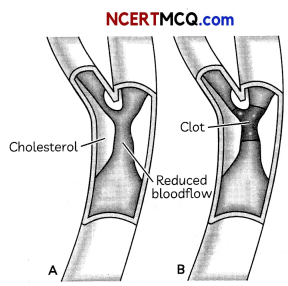
Substantiate by giving two reasons as to why a holistic understanding of the flora and fauna in the cropland is required before introducing an appropriate biocontrol method. (2)
Answer:
Streptokinase (produced by the bacterium Streptococcus) is used as a ‘clot buster’ for removing dots from the blood vessels of patients who have undergone myocardial infarction.
Statins (produced by the yeast Monascus purpureus) acts by competitively inhibiting the enzyme responsible for synthesis of cholesterol and thus act as blood- cholesterol lowering agents.
Related Theory
Myocardial infarction is commonly known as a heart attack and is a deadly medical emergency, in which the heart muscle begins to die because it does not get enough blood flow due to a blockage in the arteries that supply blood to the heart. Blockage can be due to cholesterol deposition.
OR
Eradication of pests will disrupt predator- prey relationships, where beneficial predatory and parasitic insects which depend upon flora and fauna as food or hosts, may not be able to survive.
Holistic approach ensures that various life forms that inhabit the field, their life cycles, patterns of feeding and the habitats that they prefer are extensively studied and considered.
Related Theory
When biological methods are used for controlling plant diseases and pests it is termed as Biocontrol. The organic farmer is aware of the fact that eradication of pests is undesirable because in their absence the beneficiary predatory and parasitic insects that depend upon them as food or hosts will not be able to survive. Therefore, the use of biocontrol agents will greatly reduce our dependence on toxic and harmful chemicals and pesticides.
Question 3.
Identify the compound chemical structure is shown below. State any three of its physical properties. (2)

Answer:
It is Morphine.
Physically it appears as a white, odourless, crystalline compound.
Related Theory
Morphine acts as a depressant and slows down body functions. It is an effective sedative and a painkiller taken by patients who have undergone surgery.
It is generally consumed by snorting and injection.
![]()
Question 4.
Water samples were collected at points A, B and C in a segment of a river near a sugar factory and tested for BOD level. The BOD levels of samples A, B and C were 400 mg/L, 480 mg/L and 8 mg/L respectively. What is this indicative of? Explain why the BOD level gets reduced considerably at the collection point C? (2)
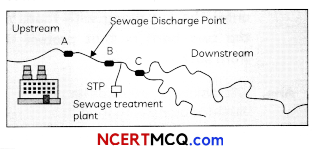
Answer:
At collection points A and B, the BOD level is high due to high organic pollution caused by sugar factory and sewage discharge.
At the collection point C, the water was released after secondary treatment/ biological treatment (where vigorous growth of useful aerobic microbes into floes consume the major part of the organic matter present in the river water or effluent due to sugar factory and sewage discharge).
Related Theory
The primary treatment is also known as physical treatment as it basically involves physical removal of small and large particles from the sewage with the help of techniques like filtration and sedimentation. The secondary treatment is also known as Biological Treatment because it involves the use of microbes for sewage treatment.
BOD can be defined as the amount of the oxygen that would be consumed if all the organic matter in one litre of water were oxidised by bacteria. The sewage water is treated till the BOD is reduced. Thus, indirectly, BOD is a measure of the organic matter present in the water. The greater the BOD of waste water, more is its polluting potential.
Question 5.
An ecologist study an area with population A, thriving on unlimited resources and showing exponential growth, introduced population B and C to the same area. What will be the effect on the growth pattern of the population A, B and C when living together in the same habitat? (2)
Answer:
This interaction will lead to competition between the individuals of population A,B and C for resources. Eventually the ‘fittest’ individuals will survive and reproduce.
The resources for growth will become finite and limiting, and population growth will become realistic.
Relcted Theory
Practically unlimited resources are not available to population of any species in order to permit exponential growth. Therefore, limited resources result in competition between individuals. A given habitat in nature, has enough resources to support a maximum possible number, beyond which no further growth is possible. This limit of nature is termed as nature’s carrying capacity (K) for that species in that habitat.
![]()
Question 6.
With the decline in the population of fig species it was noticed that the population of wasp species also started to decline. What is the relationship between the two and what could be the possible reason for decline of wasps?
OR
With the increase in the global temperature, the inhabitants of Antarctica are facing fluctuations in the temperature. Out of the regulators and the conformers, which of the two will have better chances of survival? Give two adaptations that support them to survive in the ambient environment? Give one suitable example. (2)
Answer:
The relationship between the plant and pollinator is called mutualism. Fig depends on wasp for pollination, and wasp depends on fig for food and shelter.
With the decline in population of figs, wasp loses its source of food and shelter.
Related Theory
In order to safe-guard the mutually beneficial system, plant-animal interactions involve co-evolution of the mutualists, i.e., the evolution of the flower and its pollinator species are tightly linked with one another. There is a tight relationship between species of fig trees and pollinator species of wasp. In this a particular fig species can be pollinated only by its ‘partner’ wasp species and no other species. The female wasp is benefltted by using the fruit as an oviposition (egg-laying) site and developing seeds within the fruit for nourishing its larvae. In return the wasp pollinates the fig inflorescence while searching for suitable egg-laying sites.
OR
Thermoregulation, Osmoregulation
Birds/mammals (any one)
Related Theory
w Conformers are the organisms which depends upon the changes in its external environment. Like aquatic animals change the osmotic concentration of the body fluids with that of the surrounding air, water osmotic concentration. They are also called as ectotherms as they depend on external sources of body heat since they cannot regulate their body temperature as per the variations in the external temperature. Examples: amphibians, reptiles,
fishes.
Regulators are the organisms that are capable of controlling their internal environment irrespective of their external surroundings to an extent. They are also called as endotherms as these animals depend on the internal heat generation for survival.
![]()
SECTION – B
(Section B has 6 Questions of 3 marks each.)
Question 7.
How do normal cells get transformed into cancerous neoplastic cells? Elaborate giving three examples of inducing agent.
OR
A person is suffering from a high grade fever. Which symptoms will help to identify if he/she is suffering from Typhoid, Pneumonia or Malaria? (3)
Answer:
Transformation of normal cells into cancerous neoplastic cells may be induced by following physical, chemical or biological agents causing DNA damage:
- Ionising radiations like X-rays and gamma rays
- Non-ionizing radiations like UV.
- Chemical carcinogens present in tobacco smoke
- Cellular oncogenes (c-onc) or protooncogenes, when activated under certain conditions cause cancer.
Viruses with oncogenes can transform normal cells to cancerous cells. (any 3)
Related Theory
The cell growth and differentiation in human body is a highly controlled and regulated process. But in cancerous cells, there is a breakdown of these regulatory mechanisms. The property by which normal cells differ from cancerous cells is contact inhibition by virtue of which contact with other cells inhibits their uncontrolled growth, whereas cancerous cells have lost this property. Therefore, the cancerous cells divide continuously to give rise to masses of cells called tumours or neoplasm.
OR
Answer:
If the person has sustained high fever (39° to 40°C), weakness, stomach pain, constipation, headache and loss of appetite, it is Typhoid.
If the person has fever, chills, cough and headache: and the lips and fingernails turn gray to bluish, it-is Pneumonia.
If the person has chills and high fever recurring every three to four days then, it is Malaria.
Related Theory
Typhoid: Bacterial infection caused by Salmonella typhi, which enter the small intestine through contaminated food and water and then migrate through blood to other organs.
Pneumonia: Bacterial disease caused by
Streptococcus pneumoniae and Haemophilus influenzae, which infects the alveoli of the lungs. The infection spreads to a healthy person by inhaling the droplets/aerosols that are released by an infected person.
Malaria is caused by Plasmodium (a tiny protozoan). The disease spreads from an infected individual to a healthy person through the vector female Anopheles mosquito. The malaria can become fatal if left untreated, by disrupting the blood supply to vital organs and thus may cause seizures, mental confusion, kidney failure, coma and even death.
![]()
Question 8.
Recognition of an antigenic protein of a pathogen or exposure to a pathogen occurs during many types of immune responses, including active immunity and induced active immunity. Specify the types of responses elicited when human beings get encountered by a pathogen. (3)
Answer:
When our body encounters an antigenic protein or a pathogen for the first time it produces a response which is of low intensity and our body retains memory of the first encounter.
- The subsequent encounter with the same pathogen elicits a highly intensified response carried out with the help of two special types of lymphocytes present in our blood, B-lymphocytes, and T-lymphocytes.
- The B-lymphocytes produce an army of proteins in response to these pathogens into our blood to fight with them. These proteins are called antibodies. The T-cells themselves do not secrete antibodies but help B-cells produce them.
Related Theory
Active Immunity: When an individual (host) is exposed to antigens in the form of living or dead microbes or other proteins. It results in the production of antibodies. This kind of immunity is slow and thus takes time to give its full effective response, but its effect is long lasting. It has no side effects.
The type of immune response produced by B-lymphocytes is termed as humoral immune response or antibody mediated immune response. The type of immune response produced by
T-lymphocytes is termed as Cell-mediated immune response or cell-mediated immunity (CMI).
Question 9.
In a pathological lab, a series of steps were undertaken for finding the gene of interest. Describe the steps, or make a flow chart showing the process of amplification of this gene of interest. (3)
Answer:
The flow chart shows the three steps involved in the process of PCR showing the following
- Denaturation The DNA strands are treated with a temperature of 94°C (Heat) and the strands are separated. Each of the two separated DNA strands act as a template for the synthesis of a new strand.
- AnneaLing The primers anneal to the complementary strands. This step is carried out at a slightly lower temperature of 40°C to 60°C.
- Extension The DNA polymerase facilitates the extension of the strands by adding dNTPs (deoxy nucleoside Triphosphates) complementary to those of the template DNA. Taq DNA Polymerase also requires Mg2+ as a cofactor.
Diagram : Polymerase Chain Reaction
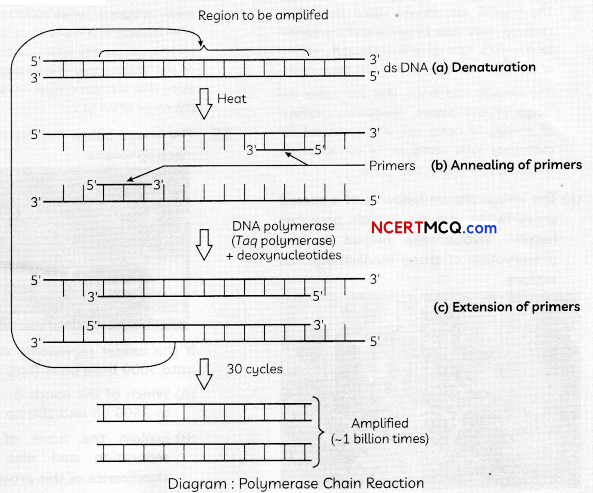
![]()
Question 10.
(A) ‘The Evil Quartet’ describes the rates of species extinction due to human activities. Explain how the population of organisms is affected by fragmentation the habitats.
(B) Introduction of alien species has led to environmental damage and decline of indigenous species. Give any one example of how it has affected the indigenous species?
(C) Could the extinction of Steller’s sea
cow and passenger pigeon be saved by man? Give reasons to support your answer. (3)
Answer:
(A) When a large habitat is broken into small fragments due to various activities, mammals and birds requiring large territories and certain animals with migratory habitats are badly affected, leading to population decline.
(B) Nile perch introduced in Lake Victoria eventually led to the extinction of an ecologically unique assemblage of more than 200 species of cichild fish.
- Portheniumj Lantana/water hyacinth caused environmental damage and threat to our native species
- African catfish-Clarias gariepinus introduced for aquaculture purposes is posing a threat to the indigenous catfishes in our rivers. (Any one)
(C) Yes; Humans have overexploited natural resources for their ‘greed’ rather than need’ leading to extinction of these animals. Sustainable harvesting could have prevented extinction of these species.
Related Theory
Examples of habitat loss:
(i) The tropical rain forests which were once covering more than 14 per cent of the earth’s land surface, now cover only about 6 per cent of the total area due to their fast destruction.
(ii) The Amazon rain forest, that are called the ‘lungs of the planet’, harbouring millions of species, is being cut and destroyed for cultivating soya beans or for conversion to grasslands for raising beef cattle.
Question 11.
(A) The image shown below is of a sacred grove found in India. Explain how has human involvement helped in the preservation of these biodiversity rich regions.
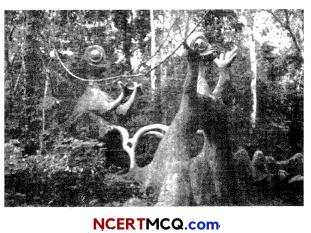
(B) Value of Z (regression coefficient) is considered for measuring the species richness of an area. If the value of Z is 0.7 for area A ,and 0.15 for area B, which area has higher species richness and a steeper slope? (3)
Answer:
(A) India’s history of religious and cultural traditions emphasized the protection of nature. In many cultures, tracts of forest are set aside, all the trees and wildlife within are venerated and given total protection. Sacred groves in many states are the last refuges for a large number of rare and threatened plants.
(B) Area A will have more species richness and a steeper slope.
Related Theory
w Sacred groves are found in Khasi and Jaintia Hills in Meghalaya, Aravalli Hills of Rajasthan, Western Ghat regions of Karnataka and Maharashtra and the Sarguja, Chanda and Bastar areas of Madhya Pradesh.
The species-area relationship is found out using the slope. Slope of regression or regression coefficient is used to measure species richness along an area. In smaller regions, an analysis of species-area relationship shows that the values of slope of regressionis the same irrespective of the taxonomic assemblage or the region. Whereas when analysis is carried out in large areas the slope of regression was found to be much steeper. Very large areas like the entire continents, the analysis of the species-area relationships will result in a slope that is much steeper i.e., the Z values are in the range of 0.6 to 1.2.
![]()
Question 12.
The image below depicts the result of gel electrophoresis
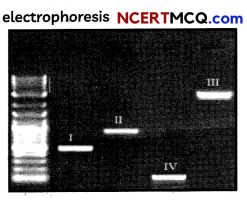
If the ladder represents sequence length upto 3000 base pairs (bp),
(A) Which of the bands (I – IV) correspond to 2500 bp and 100 bp respectively?
(B) Explain the basis of this kind of separation and also mention the significance of this process. (3)
Answer:
(A) Band III corresponds to 2500 base pairs, and Band IV corresponds to lOObp.
(B) The fragments will resolve according to their size. The shorter sequence fragments would move farthest from well as seen in Band IV (100 bp) which is lighter as compared to Band III which is heavier being 2500 base pairs.
The significance of electrophoresis is to purify the DNA fragments for use in constructing recombinant DNA by joining them with cloning vectors.
Related Theory
The basis of gel electrophoresis is that the DNA fragments separate according to their size through sieving effect provided by the agarose gel. Therefore, the smaller the fragment size, the farther it moves.
The purified DNA fragments (containing gene of interest) are used in constructing recombinant DNA by joining them with cloning vectors with the help of DNA ligase.
SECTION – C
(Section C has a case-based question of 5 marks.)
Question 13.
Some restriction enzymes break a phosphodiester bond on both the DNA strands, such that only one end of each molecule is cut and these ends have regions of single stranded DNA. BamHl is one such restriction enzyme which binds at the recognition sequence, 5’-GGATCC- 3’ and cleaves these sequences just after the 5’- guanine on each strand.
(A) What is the objective of this action?
(B) Explain how the gene of interest is introduced into a vector.
(C) You are given the DNA shown below.
5’ ATTTTGAGGATCCGTAATGTCCT 3’ 3’ TAAAACTCCTAGGCATTACAGGA 5’
If this DNA was cut with BamHl, how many DNA fragments would you expect? Write the sequence of these double-stranded DNA fragments with their respective polarity.
(D) A gene M was introduced into E.coli cloning vector PBR322 at BamH 1 site. What will be its impact on the recombinant plamids? Give a possible way by which you could differentiate non recombinant to recombinant plasmids.
OR
GM crops especially Bt crops are known to have higher resistance to pest attacks. To substantiate this an experimental study was conducted in 4 different farmlands growing Bt and non Bt-Cotton crops. The farm lands had the same dimensions, fertility and were under similar climatic conditions. The histogram below shows the usage of pesticides on Bt crops and non-Bt crops in these farm lands.
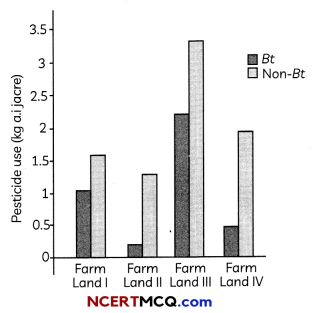
(A) Which of the above 4 farm lands has successfully applied the concepts of Biotechnology to show better management practices and use of agrochemicals? If you had to cultivate, which crop would you prefer (Bt or Non- Bt) and why?
(B) Cotton Bollworms were introduced in another experimental study on the above farm lands wherein no pesticide was used. Explain what effect would a Bt and Non Bt crop have on the pest.
(5)
Answer:
(A) The two different DNA molecules will have compatible ends to recombine.
(B) Restriction enzyme cuts the DNA of the vector and then ligates the gene of interest into the DNA of the vector.
(C) 2 fragments
5’ ATTTTGAG 3’5’GATCCGTAATGTCCT 3’ 3′ TAAAACTCCTAG 5’.3’GCATTACAGGA 5′
![]()
(D) BamHl site will affect tetracycline antibiotic resistance gene, hence the recombinant plasmids will lose tetracycline resistance due to inactivation of the resistance gene.
Recombinants can be selected from non recombinants by plating into a medium containing tetracycline, as the recombinants will not grow in the medium because the tetracycline resistance gene is cut.
Related Theory
Each restriction endonuclease acts by ‘inspecting’ the length of a DNA sequence. On finding its specific recognition sequence known as palindromic nucleotide sequences, the enzyme binds to the DNA and cut each of the two strands of the double helix at specif c points in their sugar -phosphate backbones.
Insertional inactivation: It is a method in which recombinants and non-recombinants are differentiated from each other on the basis of their ability to produce colour in the presence of a chromogenic substrate. This method was developed as selection of recombinants due to inactivation of antibiotic gene is an inconvenient method in terms of simultaneous plating on two plates having different antibiotics.
OR
(A) Farm Land II.
Bt crop.
Because the use of pesticides is highly reduced for Bt crop // Decrease of pesticide used is also more significant for Bt crop.
(B) In Bt cotton a cry gene has been introduce from bacterium Bacillus thuringiensis (Bt) which causes synthesis of a toxic protein. This protein becomes active in the alkaline gut of bollworm feeding on cotton, punching holes in the lining causing death of the insect.
However; a Non-Bt crop will have no effect on the cotton bollworm/the yield of cotton will decrease/non-Bt will succumb to pest attack.
Related Theory
Bt cotton is created using the bacterium Bacillus thuringiensis as some strains of it produce proteins that kill certain insects such as lepidopterans (tobacco budworm, armyworm), coleopterans (beetles) and dipterans (flies, mosquitoes).
Protein crystals are formed by B. thuringiensis during a particular phase of their growth. A toxic insecticidal proteinis present in these crystals. The bacterium itself is not affected or killed by this toxin because the Bt toxin protein exist as inactive protoxins, but when an insect feed on such a plant and ingest the inactive toxin, the protoxin gets converted into an active form due to the alkaline pH of the gut, that solubilize the crystals.